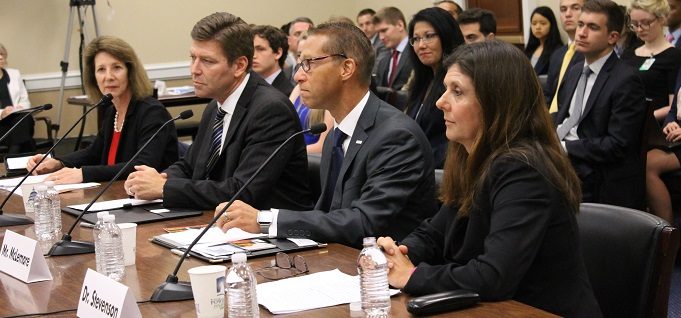Finding skilled workers for 6M available jobs
By Ellie Ashford
July 19, 2017
Education leaders tell lawmakers how their colleges are closing the skills gap.
One of the reasons for the widening gap between the number of available jobs and qualified employees is an overemphasis on bachelor’s degrees as the only postsecondary path, according to David Harrison, president of Columbus State Community College (Ohio).
In fact, Harrison told the congressional Joint Economic Committee on July 12 that jobs requiring an associate degree are actually growing three times faster than those requiring a bachelor’s degree.
That disconnect between available jobs and skilled workers is why the committee held a hearing on potential solutions. There are some 6 million job vacancies in the U.S., according to the committee.
“Something is not yet right with the labor market,” said committee chair Rep. Pat Tiberi (R-Ohio), who noted that while the nation’s unemployment rate is low, many prospective employees are sitting on the sidelines.
Following pathways
Lawmakers and education and workforce advocates at the hearing highlighted the importance of partnerships in gauging the needs of businesses and translating those into required job skills. The second part of the equation is sharing that information with job seekers.
“Community colleges have a critical role to play because they understand the needs of local employers,” said Sen. Martin Heinrich (D-N.M.), the ranking minority member of the committee.
He cited a federally funded partnership involving Central New Mexico Community College, employers and state agencies to create an information technology pipeline by providing training, work experience and job placement.
Studies have shown that community colleges can increase the earning power – and thus the upward economic mobility – of their students, said Diana Furchtgott-Roth, a senior fellow and director of Economics21 at the Manhattan Institute. She cited the American Association of Community Colleges’ Pathways Project as a good way to guide students into better-paying professions.
Columbus State, which is one of 30 community colleges in the Pathways Project, has forged strong partnerships with employers, K-12 districts and universities, Harrison said. One example is the Credits Count program, a partnership with the American Electric Power Co. (AEP), the AEP Foundation and Columbus City Schools, that allows high school students to earn college credits in STEM-related fields.
Another example is the New Skills at Work Initiative, funded by JPMorgan, which supports Columbus State’s grades 9-14 career pathways model throughout central Ohio.
The college also partners, along with other colleges and universities in Ohio, with the Insurance Industry Resource Council to create an educational pathway to prepare veterans and older workers for jobs in the insurance industry.
One way Congress can support career training programs, Harrison suggested, is to enact the JOBS Act (Jumpstart Our Businesses by Supporting Students), which would allow students to receive Pell grants for short-term job training.
Generating interest
Partnerships at Columbus State are also critical to incumbent workforce training strategies, Harrison said, noting that college faculty are assigned full time to a Honda facility to train employees for career advancement with the company.
Scot McLemore, talent acquisition manager with Honda North America, said the problem in filling job vacancies is not just due to the skills gap; “There’s a shortage of young people interested in manufacturing,” he said.
“Our ability to create a line of sight for parents and students in middle school gives them a glimpse of what it’s like to be in a modern manufacturing environment,” McLemore said. Once parents understand those opportunities, “it’s like a light bulb going off.”
To help create excitement around manufacturing jobs, Honda teamed with other companies and organizations to create an educational video game for middle-school students, developed mobile labs to give youths hands-on experiences with robotics and hosted STEM-focused summer camps.
There’s more to the story. Read about possible policy solutions in the original CC Daily article.


